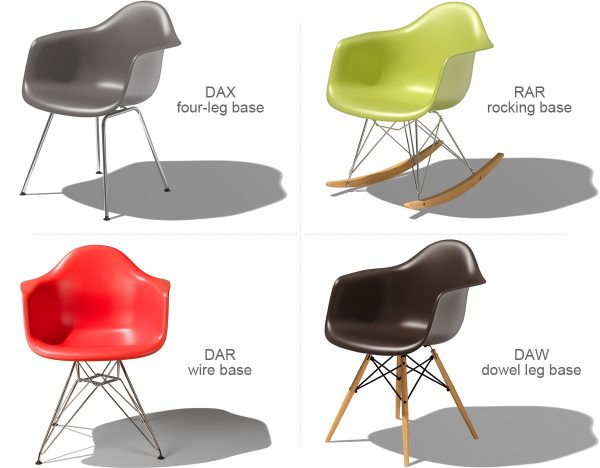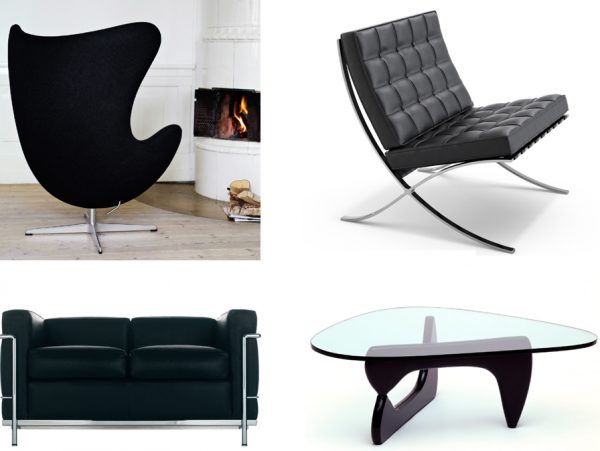More Real than Fake?
Charles and Ray Eames were two of America’s most influential Modern designers. In the mid-1900s, they made all kinds of architecture, products, graphics, films, toys and furniture, including an iconic lounge chair. This lounger very distinctive, featuring a molded plywood frame set on a metal base and usually topped with black leather upholstery. There are plenty of knockoffs of that chair and its matching ottoman.
Charles Eames once said that this 1950s lounge chair was designed to be soft and cushy because he was sick of people complaining about how uncomfortable modern furniture was. And some of those complaints were a response to another bestselling series of molded plastic and fiberglass chairs the Eameses designed a few years earlier.
These were modular, featuring a curved seat shell (with or without arms) and various bases. Buyers could pick a base for the home or for the office, something minimalist or something more stylish. But the chairs weren’t just designed to look nice. They were also meant to be affordable and functional, low-cost and easy to mass-produce. The first prototype was built for an International Competition for Low-Cost Furniture Design hosted by the Museum of Modern Art in New York.
The chair took second place. Some have speculated that although the jury was impressed by its modularity, they may have questioned the use of stamped steel for this first prototype (which was expensive and difficult to produce, requiring high pressures and temperatures). After the competition, the Eameses switched to fiberglass-reinforced plastic.
And while this chair was, by design, much simpler to make than the famous 77-step Emeco 10-06 chair, the two have some things in common, including the fact that companies love to make knockoffs of them. The Eames chair with an “Eiffel Tower” base — a set of four legs with thin criss-crossing metal connectors — is copied in part because the Vitra-licensed originals can cost over $500. Protection laws vary, so whether these various copies are legal depends on the place.
In the U.K., for instance, it used to be that copyright lasted for 25 years from the date of creation. But in 2016 they changed the rules, extending protections up to 70 years after the death of a creator. And that shifted the copyright status of lot of Modern classics, including Eames chairs but also the Arne Jacobsen Egg Chair, Mies van der Rohe’s Barcelona Chair, Le Corbusier’s LC2 sofa, Isamu Noguchi’s glass coffee table and others. And Vitra, the company that owns the rights to the molded Eames chairs, was a big force behind this change.
A lot of people rushed to buy replicas ahead of the British law going into effect. And when Aldi started advertising a “pair of retro-style Eiffel chairs” (that look a lot like Eames chairs) for under $100 in the UK, it went viral and there were opinions on all sides. Some argued the design should be protected, but an architecture and design critic who writes for the Guardian defended the retailer, asking: “Isn’t this exactly what Charles Eames would have wanted?” Of course, Charles and Ray have passed, so we’ll never be sure, but one might wonder if they would have seen the copies as more “real” than “fake” in some sense. After all, mass-accessibility was a big part of the original design intent.








Comments (18)
Share
“…if you wanna be stylish and have a house that nice and you don’t have a ton of money you may buy a knock-off chairs”
What kind of argument is that? Maybe then we should allow to buy and sell knock-off Rolex or Lamborghini? No. Design is one of the parts of intellectual property of object and should be protected by law.
Don’t have the money? Don’t buy that chair. There are plenty other stylish and affordable designs in the world.
I love 99Percent, but I’m calling “Foul!” on this episode for the sole reason that the chair-toss was a cheap tease that lazily evades an essential difference between science and engineering — the latter being the chief domain of designers.
Manufacturers thrive on anecdote and untested claims, just like Wilton Dignes eight-floor toss. Unless you subject other products to the exact same test, not to mention document the methods and results and submit them to public scrutiny, then you have only an unchallenged anecdote that lives on as myth.
Roman was journalistically irresponsible not to follow through on that test. True, 99Percent isn’t investigative journalism by any stretch. But it also shouldn’t become complicit in perpetuating anecdotal myths when they might be easily and conveniently challenged.
Really, Roman, it was a cop-out to hide behind liability and not follow through tossing the Crate & Barrel knock-off. It only suggests you’re afraid the result might show the Navy chair to be really quite ordinary. And while we’re on the topic, just where’s the paperwork showing the results of those torpedo tests?
I have an authentic Eames chair I’ve been trying to sell, but potential buyers keep trying to talk me down in price by telling me it’s a fake. It’s really maddening, especially when they can point to YouTube videos about spotting fakes made by wannabe furniture experts who have no idea what they’re talking about.
Open source furniture is the way forward!
http://www.opendesk.cc
Boy, that was a tough one that surprisingly got my hackles up. As a designer and creator who has had intellectual property stolen, it is frustrating to hear someone defend a knockoff. Knockoffs aren’t altruistic – they are absolutely opportunistic. It entails riding a trend or design or idea for personal gain, not somehow delivering an iconic design to the masses. It is not for the societal good; it is capitalistic as hell.
How about this: I’ll write a book called The Knockoff-Knockoff Economy: How Imitation Sparks Aggravation. I hope it doesn’t affect Sprigman’s bottom line, but why should I care if it puts a little extra coin in my pocket at his expense? If he really wanted this information out there for everyone’s benefit, then he would have published it for free (like 99PI). It’s fair game then, right?
If a person wishes to be altruistic and allow their work to be copied and/or improved upon, they leave it open-source. Adam Savage does this a lot (he can afford to do so). However, if a person wishes to retain that information, even if for personal gain, that wish should be observed for it’s lawful term. Granted, I think protections should expire after a reasonable period, but respect each other’s work – Theft is theft.
We are all inspired by others. If a particular design inspires a new direction, fantastic – that’s innovation. I am inspired all the time, and you should be, too. However, if you make modifications and call it yours, you are stealing (or plagiarizing, infringing, faking, counterfeiting…). It is, to me, the same as Vanilla Ice calling the beat for “Ice Ice Baby” his original, when it is clearly Bowie & Queen’s “Under Pressure”. Was it innovative? It’s arguable. They settled out of court. Give credit where it’s due or get your own ideas, would ya?
I love you, 99PI – keep up the good work. Especially because, it makes me think!
To counter those design lovers above, I think it was great to have some perspective from the pro knock off crowd. The claim of 70 years after death of the creator is an absurd length of time for the monopoly of gains from these types of products. While as a staunch capitalist I see the value in property rights, the argument that “mine will last longer” is something the market can and does appropriately value. Using the law to shut down any competition for potentially 150 years is insane. If you want to regulate waste, then regulate waste. Stopping production in the first place is not the solution.
Knockoffs aren’t altruistic, they are regular people trying to apply open market principles on unnatural monopolies provided by a government. While rewarding creators for their creations has value, the protection supposedly provided to designs like this is far too extensive, and limits progress as a society in the exact method as described on the show, by restricting availability solely to the rich.
The point of the legal framework is to benefit society by meeting the need of creators for remuneration (and thus chosing to create in the first place). If the creations aren’t actually available to society due to absurd price demands, what’s the point of protection? If you don’t want regular people to have access to your creations, why not just live as a personally sponsored creator by a rich person or corporation who can keep it all as trade secrets?
Is nobody bothered by the fact that these jerks probably jacked up the prices on their aluminum chairs by 10x because Italian designers were buying them? Aluminum is one of the cheapest materials you can make something out of and they’re marketing it like it’s the second coming of Jesus. This chair is probably worth 50 bucks, which is why the knockoffs cost about that much. 550 dollars for a freaking aluminum chair is nonsense. Nobody should pay that price for this.
Hearing this story reminded me of Kotobuki, a Japanese company that produces not only chairs (since it’s founding in 1914), but also capsule hotel modules, which I toured a couple months ago for work related reasons.
Would love to hear a story on capsule hotels!!!
https://www.kotobuki-seating.co.jp/en/company/history.html
The chair in the Dark Knight clip appears to be a knock-off as well! A good view of its four slats flashes briefly at the 4:00 mark.
Good eye! It’s authentic, but it’s a variant design with added cushions and slightly different details like that.
(Copying from my comment on Reddit)…
I was really interested in this podcast as I have a couple of these chairs…kind of. I have 2 chairs that were salvaged from a major manufacturing company (taken out of the smoking room in the 80’s). They were incredibly filthy with nicotene and other stains of which I won’t speak, but cleaned up beautifully. I knew the design was for the Navy, but wasn’t familiar with Emeco….just keep them around because they’re cool. However, they’re not Emeco chairs – they’re Goodform chairs manufactured by General Fireproofing, which I always assumed was a knock-off..looks like they were manufactured in 1954. However, the podcast episode got me wondering again and I started looking into things again….
So here’s the plot twist – I saw a couple of chairs listed on Ebay with the note that “Originally designed at the request of the US Navy to be used on Navy ships and submarines, General Fireproofing Company began manufacturing these chairs in 1936. The GoodForm chairs have since become one of the most recognizable products of the 1930s and 1940’s, and their aluminum chair design was eventually used by the Emeco company as well, who still continue to manufacture chairs today in this design. ”
So, it sounds like maybe Dinges of Emeco really didn’t design these originally?? Now I’m very curious.
Concerned about pricing out of reach of the lower classes? Buy it used.
There is no used market if nobody wants to sell theirs.
Should have called the episode “77 Steps – Benjamen Walker is in this one” so I would not have waited almost two weeks to listen to it.
Just spotted a knockoff Crate and Barrel “delta chair” in season 2 episode 10. St about the 3 minute mark.
Of West World on HBO
Great episode and I think that its funny that people take so much offense at people copying chairs. I can’t imagine a carpenter in the 1700s taking someone to court for “copying the design of their chair”. This is what happens when designers care more about making money then making a more comfortable and efficient world. Also a couple typos in the first paragraph you say “In response, engineer named Wilton C. Dinges” it should say “In response, an engineer named Wilton C. Dinges”. Also you say “Some argued the the design should be protected” when it should say “Some argued the design should be protected” only one the.
Great episode! The Eameses were aware that knock-offs existed during their lifetime and would continue to be made after their deaths, but they did not approve of them. In 1960, the Eames Office made a poster that said “Beware of Imitations — Enjoy the comfort of the REAL THING designed by Charles Eames for Herman Miller Inc. These are the ORIGINALS! Accept no substitutes.”